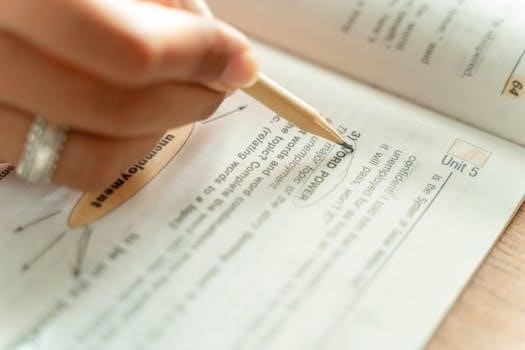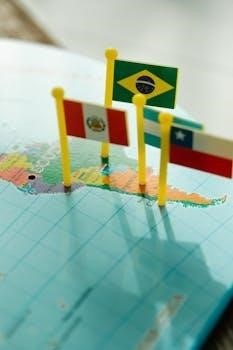Unit 6 Study Guide⁚ Government

This study guide is designed to help you navigate the complexities of government. It will cover key aspects such as policymaking, the executive branch, and the judicial system. This guide is designed to help you prepare for the exam, by reviewing key concepts and terms that will be covered.
Policymaking is a complex process involving numerous actors and stages. It is the process by which governments create laws and regulations. This unit explores the intricacies of how policies are formulated, implemented, and evaluated within the American governmental framework. It delves into the various stages of the policymaking process, starting from the identification of a problem to the final implementation and assessment of a policy. Understanding this process is crucial to grasping how governance functions. We will examine the roles played by different branches of government, interest groups, and public opinion in shaping policies. The policymaking process is not linear; rather, it’s a dynamic and iterative cycle. We’ll analyze how ideas are transformed into concrete actions, the challenges involved, and the impact these decisions have on society. In addition, we will explore how different political ideologies influence policy formation. This will include considering the influence of both domestic and international factors on the policymaking process. We will also examine the role of the bureaucracy, which plays a pivotal part in implementing policies. The study of policymaking is essential for understanding how the government impacts the lives of citizens. This introduction provides the foundation for a detailed exploration of the topic, focusing on the dynamic interplay of forces that mold American governance and its outputs.
The Presidency and Executive Branch
The Presidency and the Executive Branch form a core component of the US government, responsible for enforcing laws and leading the nation. The President serves as both head of state and head of government, wielding significant power over domestic and foreign policy. This branch includes various agencies, departments, and staff that help the President carry out his duties. Understanding the structure and function of the Executive Branch is crucial for comprehending how the government operates. The president’s powers include the ability to issue executive orders, appoint officials, and negotiate treaties. The Executive Branch also houses the vast bureaucracy, which plays a significant role in implementing policies. The president’s relationship with other branches of government, especially Congress, is often complex. This relationship is marked by both cooperation and conflict. This section will examine the checks and balances that restrain presidential power. We will analyze the different roles of the president, from chief diplomat to commander-in-chief. The influence of the executive branch on policymaking, both domestic and international, is substantial. This analysis will encompass the various facets of the presidency. It will explore how the president influences the political landscape and shapes the direction of the nation through executive actions.
Formal Qualifications for the President
The Constitution sets forth specific formal qualifications that an individual must meet to be eligible for the presidency. These qualifications are explicitly outlined to ensure that the person holding the highest office in the land meets certain basic criteria. Firstly, a candidate must be a natural-born citizen of the United States. This requirement means that the individual must have been a citizen from birth, either by being born within US territory or to US citizens. Secondly, the Constitution mandates that the president must be at least 35 years of age. This minimum age is intended to ensure the president has sufficient experience and maturity. Thirdly, a presidential candidate must have been a resident of the United States for at least 14 years. This residency requirement seeks to ensure that the president has a strong connection to the country and understands its issues. These formal qualifications are non-negotiable and must be met before anyone can be considered a candidate for the highest office. They are designed to protect the integrity and stability of the presidency. These criteria help guarantee a level of experience and commitment. The requirements are foundational to the democratic process, ensuring those who seek the presidency meet these basic standards.
Informal Qualifications for the President
Beyond the formal qualifications outlined in the Constitution, there exists a set of informal qualifications that significantly influence who can realistically become president. These unwritten requirements often play a crucial role in the selection process. While not legally mandated, they are deeply ingrained in the American political landscape. One such qualification is a strong educational background, often a bachelor’s degree, or even a graduate degree. Candidates are also expected to possess prior political experience. This often involves holding positions at the state or federal level. A successful track record in government or public service is extremely helpful. Furthermore, a candidate is expected to have demonstrated leadership abilities. They need to inspire confidence and demonstrate an ability to make decisions. Effective communication and public speaking skills are also crucial. A president must be able to articulate their vision and connect with voters. A candidate’s access to significant financial resources is another factor. Running a successful presidential campaign requires a lot of money. Finally, a candidate needs to have a certain level of name recognition and public appeal. This includes an ability to connect with diverse groups of voters. These informal qualifications, while not on paper, are essential for anyone seeking the presidency.
Presidential Term and Limits

The President of the United States serves a term of four years. This duration was established by the Constitution, which also sets limits on how many terms a president can serve. Originally, there was no explicit term limit, and presidents could serve as many terms as they could win. However, after Franklin D. Roosevelt’s four terms, concerns over concentrated power led to a constitutional amendment. The 22nd Amendment, ratified in 1951, limits a president to a maximum of two terms. A president who has served more than two years of another president’s term can only be elected once. This means that a president could serve a total of up to ten years. This amendment was put in place to ensure that there would be a periodic transfer of power. It also addressed the issue of one person being in control for too long. The term limits are a key element of the American political system. They reinforce democratic principles and prevent the potential for a president to become entrenched in power. These limits are designed to protect the republic and ensure a balance of authority. The system ensures that no single person can dominate the presidency for an extended period.
The Bureaucracy
The bureaucracy is a complex system of government agencies that implement and enforce laws and policies. These agencies operate at the federal, state, and local levels, and they are responsible for carrying out the day-to-day functions of government. The bureaucracy includes various departments, agencies, commissions, and other government entities. These entities are staffed by civil servants who are not elected officials. The bureaucracy is essential for the government to operate effectively. It provides expertise, continuity, and stability in government. Bureaucratic agencies handle a wide range of tasks. These include everything from managing social security and Medicare to protecting the environment and regulating industries. The bureaucracy has a significant impact on the lives of citizens. It influences the way laws are interpreted and applied. It is also involved in various aspects of public life, from health care to education. While it can be an efficient means of carrying out government tasks, it can also be the subject of criticism. Issues such as inefficiency, excessive red tape, and lack of accountability are often cited as reasons for concern.
Foreign Policy
Foreign policy is the set of strategies and actions a nation undertakes in its interactions with other countries. It is the way a government manages its relationships with foreign nations. It encompasses a wide range of issues including diplomacy, trade, military alliances, and international aid. Effective foreign policy seeks to promote national interests, maintain security, and foster international cooperation. The development of foreign policy is influenced by many factors. These include domestic politics, economic considerations, and global events. The president, along with the executive branch, plays a significant role in shaping foreign policy. The president often works with the Department of State and other government agencies. They are responsible for negotiating treaties, appointing ambassadors, and conducting diplomatic relations. The Congress also plays a role in foreign policy by declaring war, approving treaties, and controlling funding. Public opinion can also have a significant impact on foreign policy decisions. Interest groups and think tanks also influence the direction of foreign policy. The ultimate goal of foreign policy is to protect national interests, maintain peace, and promote stability in the international community.
State Functions and Federal Regulation
State functions encompass the various responsibilities and services that state governments provide to their citizens. These functions are essential for maintaining public order, promoting the welfare of the population, and facilitating economic growth. Typically, state functions include education, public safety, infrastructure maintenance, and the administration of state laws. States have the authority to regulate various aspects of life within their borders; This includes areas like professional licensing, zoning, and environmental protection. However, the federal government also plays a significant role in regulating certain state functions. The federal government often seeks to regulate areas that have a national impact. For example, environmental protection, interstate commerce, and civil rights. These regulations ensure consistency and prevent states from undermining national interests. This creates a complex relationship between state and federal regulation. It often leads to debates about the appropriate balance of power. Some argue for greater state autonomy, while others emphasize the need for national standards. Finding the right balance between state functions and federal regulations is a constant challenge in American governance.
Interest Groups and the Federal System
Interest groups play a significant role in the federal system by advocating for their members’ interests at various levels of government. The structure of the federal system, with its division of power between the national and state governments, provides multiple access points for interest groups to influence policy. These groups understand that decisions made at the federal level can affect them, and so they actively seek to shape those decisions. Simultaneously, they also recognize the importance of state-level policies and lobby state governments. The federal system’s decentralization allows interest groups to target specific levels of government that are most receptive to their goals. For instance, a group seeking stricter environmental regulations might focus its efforts on states known for being environmentally conscious. Conversely, groups that oppose these regulations might concentrate on states with more industry-friendly policies. This multi-layered approach enhances the influence of interest groups, enabling them to pursue their objectives through a range of strategies. This includes lobbying, grassroots mobilization, and campaign contributions. The federal system thus creates a dynamic environment for interest groups to operate within.
Judicial Branch and its Powers
The judicial branch, as outlined in Article III of the Constitution, is a cornerstone of the U.S. government, responsible for interpreting laws and ensuring their adherence to constitutional principles. The judicial power is vested in the Supreme Court and any inferior courts Congress may establish. A key power of the judicial branch is judicial review, enabling courts to invalidate legislative and executive actions that are deemed unconstitutional. This power, not explicitly stated in the Constitution, was established through the landmark case of Marbury v. Madison. The Supreme Court holds ultimate authority in interpreting the Constitution, setting precedents that shape legal practices and policy across the nation; The judicial branch also has the power to hear cases related to federal laws, treaties, and disputes between states. The court system is structured hierarchically, with district courts at the base, followed by appellate courts, and the Supreme Court at the summit. This structure allows for a system of appeals, ensuring that legal decisions are thoroughly examined. Through its various powers, the judicial branch plays a vital role in maintaining the rule of law and upholding the balance of power within the government.

Public Opinion and Political Parties
Public opinion, the collective attitudes of citizens, plays a vital role in shaping the political landscape and influencing government decisions. Political parties act as crucial intermediaries between the public and the government, organizing and mobilizing voters, and articulating policy positions. Party identification, an individual’s attachment to a particular party, is a significant factor in shaping voting behavior and political engagement. Political culture, the shared values and beliefs of a society, influences the formation and expression of public opinion. Political parties serve several key functions, including nominating candidates for office, coordinating electoral campaigns, and providing a framework for policy-making. They help to translate public preferences into concrete government actions. However, the influence of public opinion can vary depending on the issue, the intensity of public sentiment, and the degree to which political parties respond to public demands. Understanding the interplay between public opinion and political parties is essential for comprehending the dynamics of democratic governance. These elements are not static; they evolve in response to changing social, economic, and political conditions. The study of these interactions reveals valuable insights into the process of policymaking and political representation.

The Government’s Role in Managing the Economy
The government plays a crucial role in managing the economy, employing various tools and strategies to achieve economic stability and growth. Fiscal policy, involving government spending and taxation, is a key instrument for influencing aggregate demand and addressing economic fluctuations. Monetary policy, controlled by the central bank, focuses on managing the money supply and interest rates to maintain price stability and full employment. The government also regulates various sectors of the economy to ensure fair competition and consumer protection. Additionally, the government provides essential public goods and services, such as infrastructure and education, which are vital for long-term economic development. Furthermore, the government manages the national debt, addressing issues related to fiscal responsibility and sustainability. The extent of government intervention in the economy is a subject of ongoing debate, with varying perspectives on the appropriate level of regulation and government involvement. The government’s role includes promoting innovation, fostering entrepreneurship, and creating an environment conducive to economic growth. The government also addresses market failures, such as externalities and information asymmetries, to ensure efficient allocation of resources. Effectively managing the economy requires a careful balancing of competing objectives and a deep understanding of complex economic dynamics.
